
All Hands Sindhupalchowk
After taking a bus for five hours away from Kathmandu, I arrived in Bharabise, the closest town to the All Hands Sindhupalchowk base. From there, I caught another bus for forty minutes up rocky, sandy terrain to put me closer to base, but still not quite there. The mountain this bus climbed (astonishingly, without breaking down or slipping) was so rocky and sandy that a group of volunteers who had hired a private car to base the day before had to get out of their car and push it up when they became stuck.
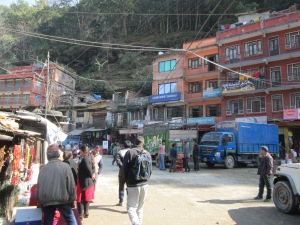
Made it to Bharabise, but still a while until base!
I finally reached Sano Sakhuwa after asking the bus driver where we were at each stop, and I hopped off the bus to find myself on a dusty road, with a mountain on one side and a steep drop to a rushing river on the other.
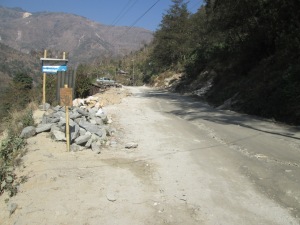
Bus stop near Sano Sakhuwa
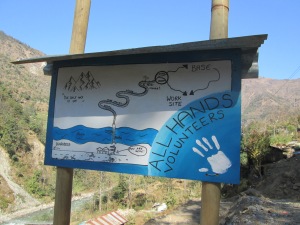
The only directions you need to get to base
Further along the road, a steep slope led to some crudely-formed stairs, leading to my worst nightmare, a suspension bridge swinging freely as the only way of passage to the other side of the river.
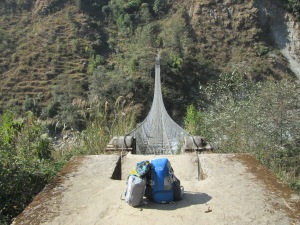
Gulp. Almost there.
A wobbly sprint across and a few dozen steep mountain-side stairs later, I arrived at the All Hands base.
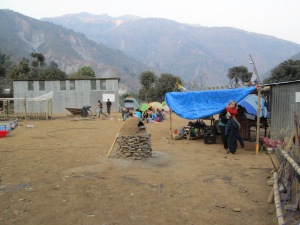
Home sweet home
It was a little different from the other bases I had been to in the past, as there was no brick and mortar building for us to live in, but rather a few dozen tents and a few free standing structures made of bamboo and CGI. Luckily for me, a bunkhouse had been finished two weeks earlier, so I didn’t have to bring a tent to base. Another bonus was that the worksite was a simple walk away – in only five minutes, we could get to and from the school site!
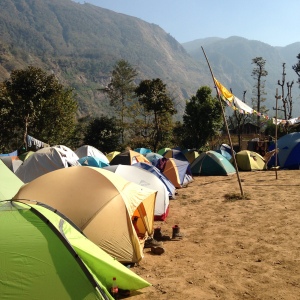
Tents!
The base was centered around a fire pit, with most of the tents pitched in a semi-circle around the pit. Next to the tents, there was a stand-alone kitchen with a table area for food. On the other edge of the tents was the bunkhouse, holding several bunks for volunteers without tents. As the dirt in our area was particularly dusty, the floor of the bunkhouse was coated with a combination of buffalo feces and clay to make a smooth dust-free surface. Luckily, I didn’t find this out until the end of my stay, and there was no apparent smell.
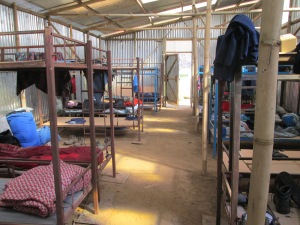
Inside the cozy bunkhouse
Our showers, bathrooms, and toolshed were all made of the same magic bamboo and CGI as the other structures, and a garden to grow fresh vegetables was in the works. Our toilets were built over a massive pit, so all of our waste would be collected under the bamboo structure, while our showers were built over a series of buckets and pipes, draining excess water into a different pit nearby. We had no running water, so we took bucket showers comprised of part boiling water from a kettle and part cold water from a nearby water source. Our drinking water was also from the nearby water source, but was filtered by some strange box that seemed to work, as I avoided the usual stomach problems that come with international travel.
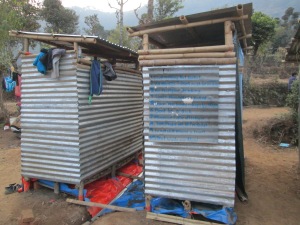
Shower stalls. Bring a bucket inside!
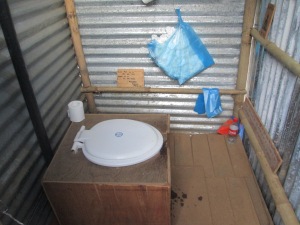
Toilet! Was relieved to see it wasn’t just a hole in the ground! Yes, I did bring my camera into the bathroom. No, nobody saw me (I hope).
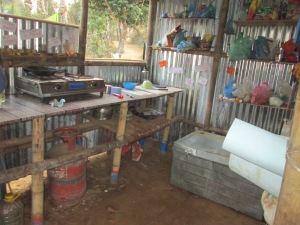
Kitchen

Magic water filtration thingy
During the day, we charged small solar powered box lights in the sun so that when night fell we had some source of light. Because these were the only lights apart from the fire pit, they were strategically strewn about the base in places like the bathrooms and path to the bathrooms. However, the solar charges only lasted until a little after 2:00am, so I avoided drinking a lot of water before bed to avoid the walk in the pure darkness.
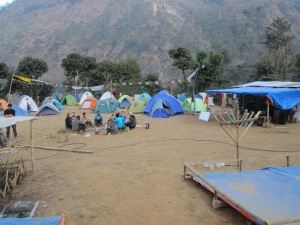
Base life = best life
Life on base was dirty, dusty, and a little bit smelly, but I’d never felt more at home. There’s something about living with the kindest strangers from all around the world with no wifi and limited electricity that made me feel like I was exactly where I wanted to be. I feel like with the hectic nomadic life I have chosen, teaching students and visiting as many countries as I can manage, it’s nice to get a break every so often to return to a place I can call home. And home doesn’t have to be a place where you know everyone, or even anyone at all. Home doesn’t have to be a place you grew up, or even a place you have been before. Home is, simply put, a place you feel at home. A place familiar and comfortable, where even the simplest things can put a smile on your face.
So as I sat down in a pile of dust, reclining in the dirt as it covered my clothes while the sun shone on my face, as I sat by a fire with a cup of tea after a long day of work with friendly strangers, as I laughed with faces hidden by the darkness as curfew rapidly approached, as I laid on the ground and stared at the clear night sky, filled with stars I never knew existed, I caught myself smiling, because I had found my way home.

…and I will be back
